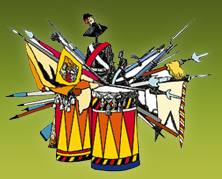Rubriky
- Války a válečníci
- Zbraně a zbroj
- Beneš(n)oviny
- Uniformy a modely
- Mrožoviny
- Vojenská technika
- Vojenská symbolika
- Bojové umění
- Miscellanea
- Toluenové opojení - galerie
- Komická sekce
- Hry
- Muzea
Codename Panzers: Phase One
Great Game, Funny Name
System Requirements Processor P3 750Mhz (P4 1.8Ghz recommended.) RAM 256Mb (512Mb recommended.) OS 98/ME/2000/XP. Video card: T&L capable 32Mb RAM (64Mb RAM recommended.) Sound card: 100% DirectX compatible Hard disk: 3 GB free space CD ROM: 8x (12x recommended.) DirectX 9.0b or better Internet connection: 56k (DSL recommended) Codename Panzers is a Real Time Strategy (RTS) game set in The European Theater of Operations (ETO) during World War Two. The game is mission-based, with the player having the option representing one of four lead characters (An American, a Britain, a German, and a Russian; the French Resistance is represented by an NPC by the name of "Michelle"). The missions are dictated by the character's storyline, though there are several missions that require you to play "out of character." The missions are of a pass/fail variety (there is no partial credit for marginal victories and defeats), though there are opportunities to complete optional mission objectives as well as secret missions. Several degrees of difficulty are available to challenge the player. Players accumulate "Prestige" during their missions (based on time of completion, losses, enemies defeated, level of difficulty, etc.) that can be used in subsequent missions to purchase additional units. Units that survive a mission are brought forward into following missions, so conservation of force is a good strategy. In addition to the single player campaigns, Panzers also offers a head-to-head multiplayer option, as well as a cooperative option, enabling numerous players to work together in completing missions. Game Play The gameplay in Panzers is aggressive and fast-paced (those of you playing the British character may want to take the SAS motto, "Who Dares, Wins" to heart). Many of the missions are timed, and to stand any chance at meeting your objectives you will need to be aggressive, mobile, and flexible. The AI is very aggressive and won't come at you like sheep to the slaughter. They WILL use cover, They WILL maneuver to hit your flanks, and they WILL use combined arms (artillery, armor, and infantry) to defeat you. The basic infantry units represented in the game are generic across the board. You have the option of rifle or SMG squads, machine gunners, anti tank (bazooka, PIAT, panzerschrek) gunners, sniper teams, tank crews, flamethrowers, mortar teams, and medics. While they are differentiated by authentic uniforms, they are identical (relative to unit type; German riflemen are the same as American riflemen) in game effect. One way of individualizing your troops is to equip them with additional gear, such as hand grenades, magnetic mines, Molotov cocktails, or explosives, which can be used during the mission. Vehicles, on the other hand, show some national differences. Each nationality has access to Artillery (both towed and self propelled) Armored Vehicles (tanks, armored cars, tank destroyers) and soft-skinned vehicles (trucks and halftracks). Two special vehicles available to each nationality, and arguably the most important, are the ammo truck and the recovery vehicle (repair truck). These two vehicles both resupply your big guns and repair battlefield damage. One unique feature of the gameplay system that warrants mention is the ability to capture enemy equipment. Cannons can be captured by assaulting them and killing the crew (tanks and artillery tend to destroy the pieces before the crews, so they should not be used). Vehicles, on the other hand, are captured by "burning out" the crew with Molotov cocktails and flamethrowers (once the vehicle gets too hot to occupy the crew will bail out, whereupon they can be killed, and the vehicle occupied.) Captured vehicles and cannons can be crewed (in the case of tanks, a tank crew is needed so if you don't have a spare crew you'll have to dismount one from one of your vehicles to occupy the captured vehicle), repaired, and resupplied just like your organic equipment, but they are not brought forward into the next mission. In selecting a force, combined arms cannot be stressed enough. Artillery is great for smashing enemy positions -- Patton once said that fixed fortifications were monuments to man's stupidity; artillery in Panzers will show you why. But artillery requires a crew (rifle squad) and a prime mover to tow it between firing positions, as well as an ammo truck to replenish its supply of shells. Infantry, while relatively ineffective against tanks (unless upgraded with firebombs or magnetic mines), are great for scouting out enemy locations (to be pounded by artillery) as well as providing elastic defenses (bend but don't break). Tanks, well they're tanks. They are not only the most powerful equipment, but they're the most expensive as well. Use them aggressively, but don't go into villages without infantry support (enemy AT rocket and flamethrower teams will eat you alive.) The Reality Issue Something that should be mentioned is that Panzers is not a historically accurate game when it comes to unit capabilities. This was a conscientious decision made on the part of CDV very early in the game development process. While the vehicles do exhibit some degree of historical accuracy -- the Panther A is more powerful than is the M4 Sherman, for example -- it is not decisively so and there is no such thing as a "one shot, one kill" vehicle, though the German rocket track does come close. CDV chose to go this route to maintain a degree of playability; in a historically accurate Russian scenario, the Russian player would receive so many T-34s for example, that his force would be unmanageable. The end result is a system that is balanced and accurate enough for all but the most inflexible wargamer. That having been said, where Panzers really shines is in the environment it provides. The detail is simply incredible. The village buildings are detailed, the terrain offers a great deal of variety, from open wheat fields to beaches and dunes, to heavily wooded forests. As mentioned, the uniforms are accurate, and the degree of detail in the vehicles is simply amazing. Encountering a PzKpfw VI (Tiger tank) for the first time will require a change of underwear; it's terrifyingly huge. The weapon effects are equally spectacular. The explosions are different enough that you can tell immediately whether you're being hit by small arms, mortar fire, tank fire, or artillery. Finally and most impressively, the entire environment reacts: Artillery obliterates trees and buildings, create shell holes, tanks knock over trees and walls (nothing makes you think of an approaching Tyrannosaurus Rex quite like watching trees fall over as something makes a bee line for your infantry). Infantry can enter almost every building, and once inside they will be shown what fields of fire they have available. As good as it is, Panzers is not without its quirks. Not really bugs, but more along the lines of oddities. Vehicles, for example, tend to follow straight paths. While all will maneuver around buildings and impassable terrain (such as non fordable rivers) and trucks will maneuver around trees (tanks just go over them, á la T-Rex) they will not follow roads, nor will they skirt obstacles, such as wire, mines, or dragon's teeth, which lie across their path; they will just drive over them. This is compounded by the fact that you cannot assign waypoints to your units, they will take the most direct route to the point you designate. This "behavior" is not a showstopper; it simply requires you to pay a bit more attention to your routes when making bold movements. Fortunately, you can issue orders to your units while the game is paused, which goes a long way to mitigating this issue. Second, while your units will readily voice their opinion regarding the assignments you give them (they will not attack a tank when they have no anti-tank weapons, or walk off a cliff) they will slaughter their own and their allies with glee and not tell you they're doing it. Again, this is "odd" but not a showstopper -- you just have to be careful about designating targets on a congested battlefield. On the Multiplayer side, where the trend has become to develop a game where single-player play is a feature rather than the focus, Panzers offers both in equal proportions. The really interesting feature is the cooperative multiplayer option. A general of antiquity once commented on the differences between allies and enemies; enemies, he said, are trying to kill you on purpose, while your allies end up killing you on accident. The challenge in cooperative mode is working as a team to get the job done; each force is a fraction of the whole and unless the players cooperate the enemy AI will defeat the individuals in detail. The Bottom Line Panzers is a slick, fast-paced RTS game with a challenging AI, and a brilliant game environment. The four storylines are unique enough that they all warrant playing, and the levels of difficulty are significant enough to present a serious challenge at the highest levels. The graphics and sound are accurate -- you'll know when there's a Ju-87 Stuka operating on the battlefield -- and realistic, while the interactiveness of the environment provides a very real combat experience. As Field Marshal Model found in the battle for Arnhem, you will find it easier to flatten buildings with artillery rather than commit troops to root them out. The gameplay rewards the aggressive player, in terms of Prestige points available to buy troops for the next mission, but not the reckless one (you only bring with you the units that survive the last mission). The number of maps and unit types available make multiplayer action attractive, while the cooperative mode represents a completely different kind of multiplayer challenge.
Foto týdne
Recenze týdne
Osobní svědectví a geopolitické pozadí rusko-ukrajinské války.





















Předmět: Jak jsem se stal tankánem